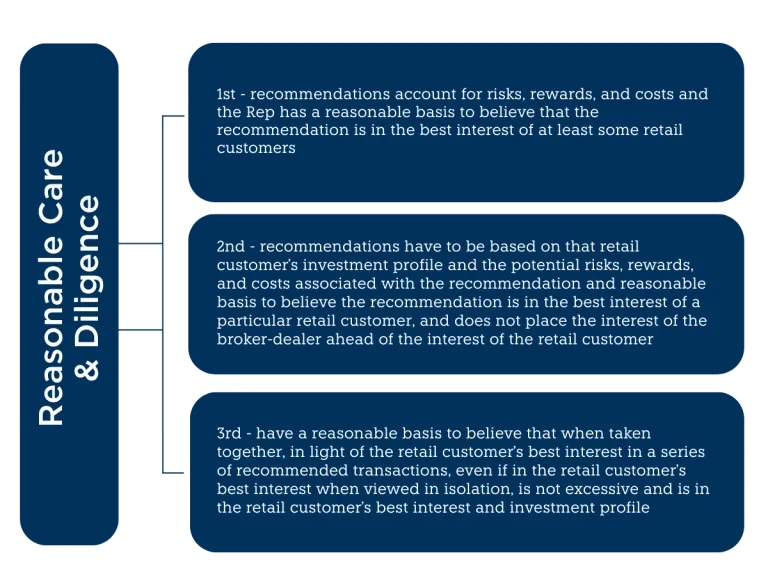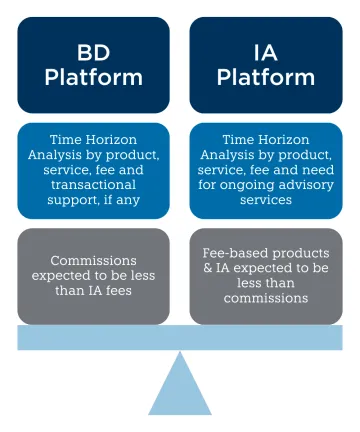Regulation Best Interest Assessment and the Next Frontier
The adoption of Regulation Best Interest (Reg BI) represents a paradigm shift, compelling broker-dealers to pivot from making investment recommendations to clients based on suitability, to recommendations in the client’s best interest. Reg BI includes four foundational obligations, the duties of disclosure, care, conflicts of interest and compliance. In addition, the enactment of Reg BI occurred during the same general time frame as the enactment of Form CRS. Thematically, these regulations sought to define conduct and disclosure requirements for the relationship with retail customers of the broker-dealer. Now that Reg BI has been in place for almost three years, the industry has received a few waves of feedback from the regulators through enforcement actions, arbitrations and additional guidance.
Initial Frontier
Initial Wave of Business Conduct Enforcement Actions
The SEC’s Office of Compliance Inspections and Examinations (now known as the Division of Examinations or EXAMS) announced in April 2020 that it would begin examining firms for compliance with Reg. BI. Two years later, the SEC brought the first case citing Reg BI violations against a broker-dealer and five of its registered representatives for recommending and selling an unrated, high-risk debt security to retirees and other retail investors. According to the SEC Complaint, the firm failed to:
- Set any criteria or thresholds for its customers to invest in the debt instruments.
- Restrict the sale of debt instruments to customers with certain risk profiles or investment objectives.
- Require the registered representatives to take any additional training focused on the most recent issuance of the bonds.
Notably, regulators will continue to focus on product training for firms recommending complex or risky products.
In its complaint, the SEC alleged that the firm and its registered representatives violated Reg BI’s care obligations because they did not understand the risks and costs associated with the bonds and recommended them to customers without having a reasonable basis to believe they were in the customer’s best interest. The case continues to be litigated in federal court for the Central District of California (United States Sec. & Exch. Comm'n v. W. Int'l Sec., 2:22-cv-04119-ODW (AFMx) (C.D. Cal. Mar. 13, 2023)).
FINRA brought its first Reg BI enforcement action in October 2022, using the opportunity to pursue a registered representative for excessive trading in a client account. The representative was charged with recommending a series of transactions in the client’s account that were “excessive in light of the customer’s documented investment profile and was therefore not in that customer’s best interest.” FINRA noted that “[n]o single test defines when trading is excessive, but factors such as the turnover rate, the cost-to-equity ratio, and the use of in-and-out trading in a customer’s account are relevant to determining whether a member firm or associated person has excessively traded a customer’s account in violation of Reg BI.”
Since this case, FINRA has an active docket of Reg. BI cases. Regulation BI ranks number ten in FINRA’s Top 15 Controversy Types in Customer Arbitrations. In 2022, 216 arbitration cases involved Reg BI violation claims, followed by 101 cases in the first quarter of 2023. As FINRA customer arbitration cases claiming Reg BI breaches continue to rise, the pressure on broker-dealers to implement and formalize their Reg BI compliance processes increases.
FINRA is also flexing its regulatory muscles, expelling a firm and its CEO for multiple violations of Reg BI and suitability standards, including making misrepresentations to clients about payments received from private placement sales, churning customer accounts, and failing to supervise its registered representatives. Christopher Kelly, FINRA’s acting Head of Enforcement, told SIFMA’s Compliance and Legal conference in March 2023 that FINRA plans to complete at least 1,000 Reg BI examinations of broker-dealers by year-end.
Next frontier
Based on the recent SEC Risk Alert: Observations from Broker-Dealer Examinations Related to Regulation Best Interest (see our blog post) and the 2023 Report on FINRA’s Examination and Risk Monitoring Program, as well as my industry experience, the next wave of Reg BI enforcement and evolution will address the products, platforms, and documentation of Reg BI analysis.

The SEC published its third Staff Bulletin (see here for March 2022 Bulletin and here for the August 2022 Bulletin) on the care obligation imposed by Reg BI and the investment adviser’s fiduciary standard. The staff states that “firms should have a reasonable process, tailored to their particular business model and investment offerings, for evaluating” reasonably available alternatives and document their basis for their choices. Investment professionals should consider risks, rewards, and costs when evaluating reasonably available alternatives.
For many firms, the most challenging aspects of the duty of care is to consider reasonably available alternatives. The staff expects firms to consider a broad array of investments or investment strategies available that are generally consistent with the investment profiles of the clients they serve, and then narrow that universe down to focus on meeting the best interests of those clients. Some complex products may have specific features that make them unique. In those situations, "[t]he staff believes that products that are not identical may still be comparable to each other for purposes of identifying them as reasonably available alternatives based on the retail investor’s investment profile, among other factors. Finally,”[t]he staff believes documentation demonstrating that the financial professional considered reasonably available alternatives can be particularly important where a recommendation may seem inconsistent with a retail investor’s investment objectives “on its face” and/or poses conflicts of interest for the firm or the financial professional.”
As emphasized by the staff, the care obligation requires due diligence by both the firm and registered representative. The initial due diligence should be performed at the firm level by reviewing the risks, rewards and costs associated with a product or investment strategy to determine whether it is appropriate for at least some of the firm’s retail clients. The next step is for the registered representative to review the retail investor’s investment profile and select the available investment product or products that meet that investor’s investment objectives and are in their best interests. Finally, there should be documentation, preferably at both the firm and registered representative level, supporting the selection of the investment product and the recommendation to that investor.

For dual registrants, the staff also addressed the difference between the Reg BI standard for brokerage accounts and the fiduciary standard for advisory accounts. “[A]lthough the specific application of Reg BI and the IA fiduciary standard may differ in some respects and be triggered at different times, in the staff’s view they generally yield substantially similar results in terms of the ultimate responsibilities owed to retail investors.”
The Bulletin also requires dual registrants to consider whether a brokerage or advisory account is more appropriate when making a recommendation. Specifically, the staff states that financial professionals should consider the “difference in reasonably expected total costs depending on whether the investment or investment strategy is held in the retail investor’s brokerage or advisory account, including but not limited to any account level costs, such as commissions, advisory fees on assets under management, or, as relevant, tax consequences, over the expected life of the investment.”

For example, the account selection analysis might require answering the following questions: Is it more or less expensive, based on the expected time horizon and activity, to have a fee-based product or a commission-based product? Does the representative expect to provide ongoing monitoring and advice for the investment product? Examples include:
- Fee-Based Annuities vs. Commissioned Annuities.
- Fee-Based Private Equity Fund vs. Commission-based Private Equity Fund.
- NTFs and ETFs “distributed” through a broker-dealer versus a registered investment adviser(“RIA”) platform.
Commission-based executions for listed securities versus RIA-absorbed executions. The representative should consider the following:
- Whether investment advisory products provide higher invested or credited value, e.g., when an investment is purchased for a brokerage account, the commission is deducted, thereby decreasing the initial account value, as compared to a purchase of the private placement distributed by the issuer through a registered investment adviser, where no commission is charged (but the investor pays an ongoing investment management fee).
- Whether the representative will provide ongoing investment advice and monitoring regarding the investment. For example, if a dual registrant believes a private equity fund is appropriate for a customer, is it cheaper for the client to pay a one-time commission instead of an ongoing asset management fee? Does the representative have the expertise to monitor the private equity fund and the capacity to do so? Given that private equity interests are subject to restrictions on transfer, does it make sense to place the asset in an advisory account, charging for ongoing investment advice if the asset itself cannot be liquidated, absent some “gating” provisions? Might a “sticky” or non-tradable asset such as a private placement have bearing, from an overall account monitoring and advisory perspective, on other assets, and therefore potentially justify an AUM fee on such private placements? If so, from a Best Execution perspective, although such an AUM fee being immediately placed on the account is not justifiable in my experience, how far after the purchase would such an AUM fee be justifiable from a Reg. BI perspective.
- Whether dual compensation streams (i.e., receiving both a commission and an investment management fee) are justifiable in any circumstances (and that analysis differs when the investment advisory and brokerage services can and would be handled by affiliated entities versus by unaffiliated entities).
Possible future enforcement actions could challenge the validity of dual compensation streams, both within the context of a broker-dealer with an affiliated investment adviser as well as with a third party, unaffiliated investment adviser. Post-Reg BI, it is difficult to imagine many scenarios where a dual compensation stream among affiliated entities could be justified. Other notable issues include:
- Whether a broker-dealer should recommend and justify using an investment adviser to manage the account on a discretionary basis, and under what circumstances and how long after a specific brokerage transaction would it be appropriate (recognizing that charging a commission, followed immediately by having the client enter an investment advisory relationship with an affiliated adviser is likely to be problematic in many cases, absent some unusually compelling facts).
- Whether a broker-dealer should recommend and can justify using an investment adviser on the account in a non-discretionary, advisory capacity, and under what circumstances and how long after a specific brokerage transaction would it be appropriate to use such a manager.
- Whether a broker-dealer can, in each particular scenario, recommend and justify having the client enter into an advisory relationship that results in the adviser “trading away” any positions either delivered to the clearing firm or “held away” from the broker-dealer.
- Whether a broker-dealer can reasonably document all order routing decisions under Rule 606 when payment for order flow (“PFOF”) is also present.
The supervision and rationale for recommending each of the account choices would require careful analysis and documentation.
The 2023 Report on FINRA’s Examination and Risk Monitoring Program outlined effective practices observed through FINRA’s oversight activities. FINRA included the following examples of effective practices for meeting a firm’s care obligation under Reg BI:
- Using worksheets, in paper or electronic form, to compare costs and reasonably available alternatives and specifying the relevant factors to consider when evaluating costs and reasonably available alternatives (e.g., similar investment types from the issuer or less complex or risky products available at the firm);
- Applying heightened supervision to recommendations of products or investment strategies that are high-risk, high-cost, complex or represent a high conflict of interest, or limiting such recommendations to specific customer types;
- Implementing new surveillance processes; and
- Incorporating Reg BI-specific reviews into the branch exam program.
Conclusion
As the regulatory and enforcement approaches evolve, and the industry gains better intelligence and perspective about the scope and full impact of Reg BI, broker-dealers need to carefully consider and document the basis for any retail recommendation about its products, strategies and, in the cases of dually affiliated firms, their platform choices. An effective worksheet or other documentation to demonstrate compliance with Reg BI. (From a firm process perspective, fee FINRA’s checklist here; from a client account strategy and product perspective, firms should go beyond the FINRA worksheet to document the particular product, strategy and recommendation details and how they are in the client’s best interest.) Moreover, supervisors must also be sufficiently conversant in the products, strategies and account alternatives to effectively evaluate such recommendations. The supervisory review processes should also be sufficiently detailed and calibrated to the alignment of the customer’s best interest with the respective products, strategies, and accounts. The following recommendations must serve the best interest of the customer:
- Invest in a particular product, against the backdrop of a range of alternative;
- Rollover assets into the firm’s investment platform;
- Implement a particular investment strategy, bearing in mind that a particular transaction may be in the best interest of a customer, while the overall strategy might not be; or
- Choose the broker-dealer or its affiliated investment adviser platform, including each of its service choices.
To demonstrate compliance with Reg BI and thereby mitigate their own regulatory risk, firms should carefully document the basis for customer recommendations and any resulting choices made.
How we help
ACA is here to help you succeed in your business, which includes providing advice about business policy and regulatory risk management. We can help you to navigate the evolving regulatory landscape while considering the complexity of your firm’s unique compliance requirements.
ACA Signature is a scalable solution curated to suit your firm’s unique compliance needs. With ACA Signature, you can choose the combination of compliance advisory services, innovative technology and managed services that is right for your firm. ACA Signature puts you in complete control of your compliance program.
To learn more about ACA Signature, contact us below.



